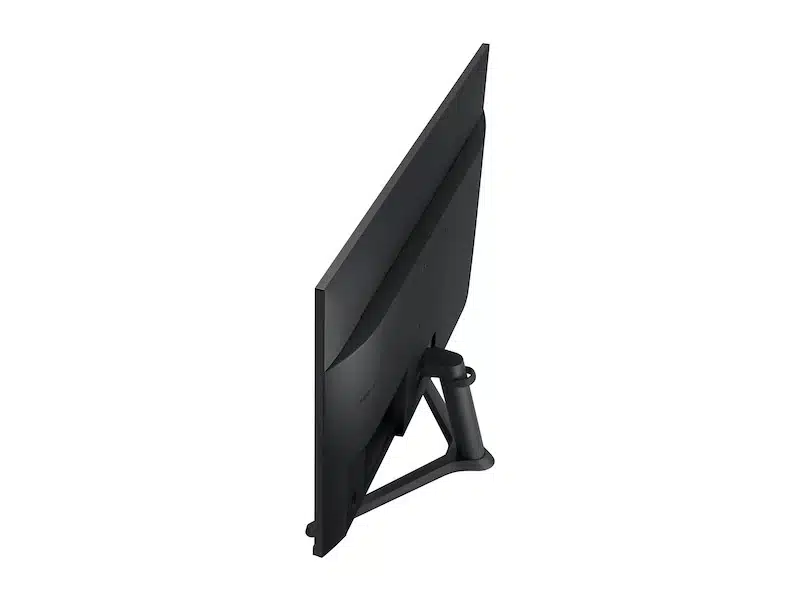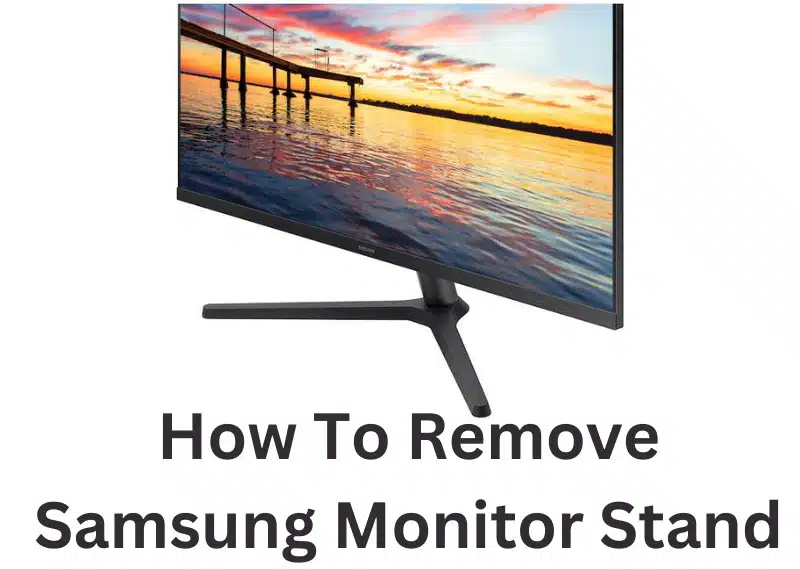Upgrading your workspace often calls for more than just getting new hardware.
Sometimes, the way you set up and arrange your gear plays a significant role in enhancing productivity.
One such instance is when you decide to mount your Samsung monitor to a wall or a dedicated monitor arm for better ergonomics and space utilization.
But before you can do that, you need to know how to safely remove the stand that your monitor came with.
Our step-by-step guide helps you accomplish this task without causing any damage to your device.
Safety Precautions
Before you start the process of removing the Samsung monitor stand, it’s important to take some safety precautions.
This will ensure that you and your monitor stay protected throughout the procedure.

First, unplug your monitor from any power sources and disconnect it from your computer or other devices.
This will prevent any electrical risks or accidental power cycling during the removal process.
Make sure you have a clean, flat, and stable surface to place your monitor when removing the stand.
Prevent damage by handling your monitor with care.
Lay it gently on a soft, non-abrasive surface to avoid scratches or dents. When working with the stand, always use the right tools and follow the manufacturer’s instructions.
If you feel unsure or encounter difficulties, consult the user manual or seek assistance from Samsung’s customer support.
One thing to keep in mind is that improper handling or any modifications made to the monitor could void your warranty.
Samsung provides a warranty for their monitors, but this might not cover damages resulting from negligence or any unauthorized alterations.
Remember to store your stand and screws safely if you wish to reattach or reuse them later.
The monitor screen itself is delicate, so refrain from pressing on it or using excessive force.
This could result in permanent damage, such as dead pixels or distortion. Always handle your Samsung monitor by the edges, avoiding direct contact with the screen.
Bear in mind that different Samsung monitor models may have unique stand removal processes.
Make sure to gather all relevant information for your specific model, and pay close attention to any details or variations included in the guide you are following.
Identifying Your Samsung Monitor Model
Before you can remove the stand from your Samsung monitor, it’s essential to identify your monitor’s specific model.
Samsung produces various types and sizes of monitors, ranging from flat budget monitors to curved LCD monitors, and each model may have slightly different stand removal instructions.
Start by examining your monitor and looking for any obvious labels or stickers that may display the model number.
Typically, you can find this information on the back or bottom of the monitor.
If you can’t locate your monitor details, try checking around the monitor’s ports (HDMI, DVI, DisplayPort, etc.).
Once you have found the model number, it’s a good idea to keep a record for future reference.
You may need this information if you’re planning to mount the display or if you need support in the future.
After you’ve identified your monitor’s model, go ahead and search for specific instructions and any relevant specs pertaining to your monitor.
You could find these details on Samsung’s official support website or via a quick search engine query.
Determining the size and type of your Samsung monitor will also assist you in the stand removal process.
For instance, larger monitors might require more careful handling or additional tools to remove the stand.
Similarly, curved monitors could have unique consideration points when compared to their flat counterparts.
By identifying your Samsung monitor model, you can now proceed with a clear understanding of the specific requirements needed for safely removing the stand without causing any damage.
Removing the Stand Step By Step

First, let’s make sure your workspace is ready. Lay a soft surface, like a padded mat or towel, on a flat table to prevent any scratches during the removal process.
Now, holding the monitor body carefully, place your Samsung monitor face down on the prepared surface.
You can use a soft cloth to clean it at this point, if you like.
Some Samsung monitor stands consist of two parts: the neck and the base.
Start by locating the screws holding the neck to the monitor. You will likely find them at the back of your monitor.
Use your screwdriver to gently remove these screws and set them aside for safekeeping.
Now, hold onto the neck and carefully wiggle it back and forth while applying slight pressure.
The neck should gradually loosen, allowing you to separate it from the monitor.
For certain Samsung monitor models, the removal process might be a bit different.
Specifically, look for a hole or hidden tab at the top of the stand neck.
If one is present, insert your screwdriver and press down gently. This motion should release the neck from the base and monitor.
And don’t forget to safely store your monitor stand, screws, and neck in case you need to reassemble them in the future.
Disconnecting Cables and Ports
Before getting started with stand removal, it’s essential to make sure your Samsung monitor is safely disconnected from all cables.
Here’s a quick guide to help you through the process:
- Turn off and unplug your monitor: Safety first! Make sure your Samsung monitor is switched off and disconnected from the power supply. This ensures it’s safe for you to handle and removes any risk of electrical shock.
- Detach data cables: Find the HDMI, DVI, DisplayPort, or any other data cables connected to your monitor. Firmly grasp the connector at the end of each cable, and gently pull it out of the corresponding monitor ports. Avoid yanking the cables or applying too much force, as this can damage the connectors or ports.
- Remove auxiliary cables: If your Samsung monitor has built-in speakers or a USB hub, there might be additional cables connected to these features. Double-check and disconnect any audio or USB cables accordingly.
- Organize your cables: Once all cables have been detached, carefully coil them up and secure them with ties or clips. This will prevent any tangles or damage while you’re working on removing the monitor stand.
Now that all cables and connectors have been safely detached from your Samsung monitor, you’re all set to proceed with stand removal.
Remember to handle your monitor carefully during this process to avoid any accidents or damage.
Preparing for Wall Mounting
Before beginning the process of mounting your Samsung monitor on the wall, make sure you have all the necessary tools and equipment.
This typically includes a wall mount, a drill with the appropriate bits, wall anchors or screws, a screwdriver, a level, tape measure, and a pencil.
First, choose the wall where you want to mount your monitor and ensure it is sturdy and free from obstructions such as electrical outlets or switches.
Measure the height and width of the monitor, taking note of the VESA mount holes on the back.
VESA stands for Video Electronics Standards Association, and these holes are a standard pattern to ensure that your monitor will fit most wall mounts.
Once you’ve selected the perfect spot for your monitor, follow the instructions provided with the wall mount.
These will guide you through the process of attaching the mount to the wall, taking into consideration the wall type, the weight of the monitor, and the specific design of the mount.
When attaching the mount to the wall, be sure to use a level to ensure everything is straight.
Now that the wall mount is secured, it’s time to remove the stand from your Samsung monitor.
Begin by disconnecting the power supply and any auxiliary cables (HDMI, DVI, DisplayPort, etc.) from the monitor.
Lay the monitor on a flat, soft surface – such as a towel or a mat – to prevent any scratches on the screen while you work.
With the monitor face-down, locate the stand hinge or bracket assembly that is attached to the back.
Depending on the model, you may need to remove screws or use a flat-head screwdriver to gently pry the stand away from the monitor.
Be cautious not to damage any internal connections or components when doing this.
Once the stand is removed, you’ll see the VESA mount holes on the back of the monitor.
Align these holes with the bracket on the wall mount, ensuring that the monitor is securely fastened in place.
Tighten all screws or locking mechanisms according to the wall mount instructions.
Now that your Samsung monitor is mounted securely on the wall, you can connect all relevant cables and power up your newly positioned screen.
Handling the Removed Stand Components
Now that you’ve successfully removed your Samsung monitor stand, it’s essential to handle the detached components with care to prevent damage or issues when reassembling them later.
I’ll walk you through some steps to ensure each part is treated properly.
First off, keep track of the monitor arm and base as these are the main components of the stand.
After removing it from your monitor, place them on a soft, clean surface to avoid scratches or potential damage.
If you had to use a Phillips head screwdriver during the removal process, make sure all the screws are safely stored in a designated container so they won’t get lost.
When detaching the back panel, you’ll want to avoid applying too much force to prevent any small clasps or connectors from breaking or bending.
Gently wiggle the panel off the monitor to keep everything intact.
Once it’s removed, inspect the panel and the area it covered for any signs of wear or damage.
If you find any problematic spots, make sure to address those before reinstalling the back panel.
When handling the components, here are a few additional guidelines to follow:
- Be gentle: Handle each piece with care to avoid damaging small plastic tabs or connectors.
- Stay organized: Keep track of all components, screws, and tools in clearly labeled containers or designated spots.
- Avoid misplacement: Store the detached parts in a safe location where they won’t be accidentally knocked over or misplaced.
- Clean as you go: Use this opportunity to gently clean any accumulated dust or debris from the monitor, stand, and back panel to maintain optimal functionality.
Additional Support and Services
If you’re still having trouble removing your Samsung monitor stand or if you need additional instructions, don’t worry – there are resources available to help you.
You can consult your Samsung monitor’s user manual, which typically contains step-by-step instructions on stand removal.
If you no longer have the physical manual, an electronic copy can often be found on Samsung’s website or through a simple online search using your monitor’s model number.
Samsung Support is another valuable resource to consider.
Their website features a wealth of knowledge on various products, including monitors, and provides solutions for common issues.
You can reach Samsung’s customer support by email, phone, or live chat, depending on your preference and the nature of your inquiry.
In case none of these resources can solve your problem, don’t hesitate to reach out to Samsung’s customer service.
Their representatives are trained to assist with various questions and concerns related to your Samsung products.
Keep in mind that Samsung offers different support channels tailored to your region and language preferences.
Remember that the online community can also provide help with removing your Samsung monitor stand.
You can search for online forums, discussion boards, videos, or articles that may have helpful information, tips, and tricks from other users who have faced the same challenge.
Though not an official Samsung support outlet, these resources can still be helpful and might give you some useful insights.
